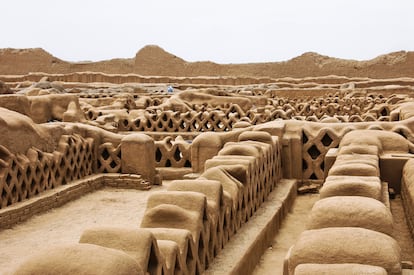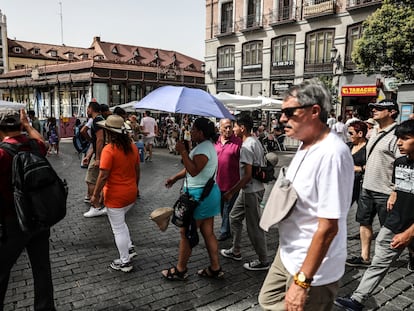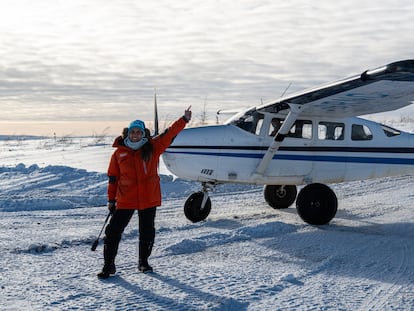Peru’s ‘Moche Route’: Mummies, pyramids, an adobe city and a stop in Trujillo
Tour the ruins of Moche and Chimú civilization, with a visit to the pre-Incan citadel of Chan Chan, the tomb of the Lady of Cao, and charming restaurants with unmatched traditional cuisine

Machu Picchu is the gold star of Peruvian tourism: the physical and cultural peak of Incan civilization and an unmatched masterpiece of architecture and engineering, located in a landscape perhaps more scenic than any on earth, and one of the New Seven Wonders of the World. But the civilization that preceded the Inca — the ancestral Mochica, or Moche, culture that flourished in ancient Peru from 100 to 800 AD, and the Chimú (Chimor) Empire that succeeded it, was similarly impressive, building major works of hydraulic engineering and leaving behind a fascinating architectural legacy. The Moche lived mainly along the northern coast of Peru — that “sleeping beauty,” as singer-songwriter Chabuca Granda once called the country, in a song whose lyrics come alive when you listen to them here: “I love you, Peru, and would roam all the forests that adorn you / And the beautiful gray that shrouds your coast / That when I climb up high turns vibrant hues.”
The work of archaeologists like Walter Alva, Régulo Franco, Carlos Elera and Bernarda Delgado has been essential for the preservation of Moche culture. Not only have their teams made important discoveries and spearheaded educational programs about this pre-Incan civilization; they have worked to protect and preserve archeological sites of an ancient people whose vestiges are now connected by a major cultural and tourist route. On the Moche Route, we visit cities, towns, beaches, carob-tree forests, and sample the incredible traditional cuisine.
To experience the full archaeological wonders of the route, we must first become familiar with terms like huaca (sacred place) and huacos (culturally significant ceramic artifacts), as well as the relevant historical periods: the early development of Moche culture (100 to 850); the Chimú period that succeeded the Moche and preceded the Inca (900 to 1470), and the reign of the Inca (1470 until the arrival of Pizarro). Led by our guides from Chaski Ventura, specialists in sustainable tourism and Peru’s cultural origins, we will explore four essential sites: the ancient city of Chan Chan, the Royal Tombs of Sipan Museum, the El Brujo archaeological complex, and the Túcume pyramids, in addition to a brief stop in northern Peru’s main city, Trujillo.
1. Chan Chan
Chan Chan is the largest adobe city in the Americas, and was declared a UNESCO World Heritage Site in 1986. It has 10 walled complexes, and was the capital of the Chimú Empire (also known as the Kingdom of Chimor) which was a very advanced civilization in terms of urban planning and the use of construction materials. The city’s walls range from 12 to 15 meters high and are 5.20 meters thick, and the ruins evidence the culture’s advanced knowledge of agriculture and irrigation, and the artisan workshops where metalworkers made their wares (archeologists have discovered a variety of burial sites with so-called “grave goods” like gold jewelry, bowls and textiles).
Chimú societies did not have a written language, hence the importance of the designs and iconography preserved in the murals that decorate some of the tombs. These visual artifacts often feature motifs related to the sea, such as fish (which Chimú people would harvest using totora reed boats, a tradition kept alive today only in the nearby city of Huanchaco). The so-called corredor de peces y aves, or “fish and bird corridor,” an engraving on the walls of Chan Chan, depicts fish and birds travelling up and down according to the cold (south) and warm (north) ocean currents. The city features engravings of pelicans and diamonds representing fishing nets, as well as the ruins of parallel channels built to contain sunken aquatic gardens, called huachaques, for the cultivation of totora reeds. Chimú societies were extremely organized, and took advantage of every resource at their disposal (using wolf fur to make sandals, for example).
Chan Chan, one of the most important cities in pre-Columbian America, is formed from a group of citadels built from adobe, and has been miraculously preserved. The palaces are delimited by walls and a single main entrance. The central square, 500 square meters in size, reflects the social organization of these theocratic societies, which were ruled by priests who left behind scepters and ceremonial cups that continue to convey their power. One can easily imagine the great priest Chimú Cápac being carried into the city on a palanquin adorned with jewels and stones, flanked by an entourage of musicians and dancers on his way to occupy the throne. (Indeed, many Chimú nobles suffered osteoporosis from never walking).
2. The Lady of Cao
The discovery of the lady of Cao in 2006 changed the history of archaeology. If all great pre-Columbian rulers were thought to be warrior priests, in this case, the warrior-ruler was a princess. A visit to the El Brujo archaeological complex and the Señora de Cao Museum is a first-class archaeological experience.
The Lady of Cao was the most powerful woman in Moche culture and ruled the northern area of present-day Peru between the 4th and 5th centuries. The major discovery came when archaeologist Régulo Franco and his team located a burial site containing an intact bundle of artifacts. Inside the bundle was the preserved, mummified body of a woman and her grave goods. The jewelry excavated at the site included necklaces, diadems and crowns, nose rings, and two scepters, indicating someone of high noble rank. The El Brujo archeological complex, located on Peru’s Pacific coast, near the mouth of the Río Chicama, includes a fascinating museum that houses a multitude of remains and artifacts found in the Huaca Cao Viejo, which are exhibited across a series of five connected rooms, one of which includes the display of the mummified body of the Lady of Cao.
Special mention must also be made of the sensitivity of architect Claudia Uccelli, who is responsible for a building that dialogues with the essence of the Moche culture itself.
“The idea of the Cao Museum was born from the search for an aesthetic comprehension of the Moche culture on the northern Peruvian coast,” explains Claudia Uccelli, the architect who designed the museum. “The management of duality with its elements of light and dark, and full and empty spaces, the materialization of the Moche’s cosmogonic world, and the placement of the buildings in the site and landscape were the starting point for a unique form that establishes new sensory parameters of perception and of the relation of interior and exterior space.” The museum is an organic, topographic structure, inserted into the landscape in such a way that its empty spaces complete it.
Since we are close to the city of Chiclayo, we must go to the Fiesta Restaurant. If archeology is like a mirror held up to a whole culture, the cuisine at this respected establishment is mirrors all the best qualities of Peruvian gastronomy, and one leaves the place levitating. Try the ceviche dish, Iceberg Mochica; or the arroz con pato (rice and duck); or the pisco sour, prepared by blending together seven varieties of pisco, and known as Cholo Number Guan, in Spanglish, and the name of the restaurant will strike you as an understatement.
3. The Lord of Sipan
Before archeologists discovered the Lady of Cao and before Ucelli designed the Cao Museum, there was another great discovery and another museum. In 1987, archaeologist Walter Alva and his team discovered the tomb of the Lord of Sipan at the Huaca Rajada site, located in Peru’s Lambayeque Valley. It was the first discovery of an intact pre-Incan Peruvian burial site, and quickly became the most important archaeological discovery in the world. So much so that the front page of The New York Times featured a story about the site, with the phrase “Step aside, Tut,” in reference to the tomb of Egypt’s King Tutankhamun.
The Royal Tombs of Sipan Museum is the work of architect Celso Prado Pastor, and its interior displays the details of the discovery of Sipan, as the archaeologists who excavated the ground would have seen it: the visitor is immersed, floor by floor, in an adventure that recreates the archaeological experience of discovering one of the most important burial sites in the Americas. Through dark corridors and displays that accurately reconstruct the rise and fall of this ancient civilization, the museum takes you on an immersive educational tour of the Sipan valley people and their administrative and religious ruler, who was buried with an impressive arsenal of gold and silver jewelry (crowns, earrings, anklets, 22-carat gold rattles, etc.), along with his wives, a child, two llamas, a dog, a soldier and a watchman.
There’s no better place to digest, so to speak, the museum experience than the nearby El Cántaro, a Lambayeque institution. Put yourself in the care of head chef Juana Zunini de Jordán, whose awards and adulations fill an entire wall in the restaurant’s entrance. Nothing here is half-baked; just pure, delectible tradition: ceviche de tollo, tortilla de raya, humitas, chingurito, chirimpico, causa a la norteña, aguadito de menudencia de pato. Oh, Lord of Sipan!
4. Tucume Pyramides
The huaca known as “Las balsas de Tucume” is another highlight of the Moche Route. It is an elongated building, 33 meters long and 25 meters wide, with a height of 4.5 meters, built over the course of seven identifiable and superimposed construction phases. The site is surrounded by 26 pyramids that make up the archaeological complex of Tucume, considered the last capital of the Kingdom of Lambayeque. Archaeologist and director of the Tucume Site Museum, Bernarda Delgado Elias, explains the site’s miraculous survival and the project of preserving the reliefs and their ceremonial marine-themed motifs, which include depictions of ancestral reed boats called “caballitos,” or little horses, for their raised bows. The place is a splendid scene of perfectly preserved art, whose central theme is nature: mythical birds, bird-men, fish and seabirds, as well as a scene of sailors and divers. The museum was inaugurated in 1993, thanks to an agreement with the Kon-Tiki Museum in Oslo and the support of Norwegian adventurer Thor Heyerdahl, renowned for his inter-oceanic expeditions. The site’s archaeological team, led by Bernarda Delgado Elías, won the British Association of Travel Writers’ award for Best Global Tourism Project at the 2015 World Travel Market.

The nearby rural guest lodge, Los Horcones de Túcume, is also worth a brief visit, or alonger stay. Designed and built by architects Jorge Burtra and Rosana Correa, the award-winning accommodation is adaptated to the surrounding environment, and features a contemporary reinterpretation of ancient adobe construction techniques.
5. Trujillo in broad strokes
As the point of departure or arrival for the Moche Route, Trujillo deserves a few notes. The great Peruvian poet César Vallejo grew up here, and the city’s foundational wall was designed by the Italian architect Joseph Formento, who took inspiration from Leonardo Da Vinci’s plans for the city of Florence. Using the same elliptical shape, and following the traces of the city’s ancient pre-Columbian wall, España Avenue surrounds the urban fabric of the place, and is the anteroom that leads to the historic center, where the cathedral and the Plaza de Armas stand out. The cathedral has a clearly pre-Hispanic yellow color and is a permanent magnet attracting the faithful and curious visitors alike. The historic center is full of colonial architecture, reflected in its large houses with wrought-iron gates, shutters and balconies. These features are well accommodated to the city’s impressive number of guariques, or small, family-run restaurant-bars.
Trujillo was founded in 1534 by Diego de Almagro — prior to that, it was the capital of the Chimú Kingdom — and was recognized a year later by Pizarro, who named the city in honor of his home in Spain: Trujillo, Extremadura. The country won independence in 1820 and commemorated the feat in 1830 with a statue that still stands today. If you find yourself hungry while wandering the city, “King Kong” alfajores are sold everywhere, and the sweet sandwiches are worthy of their name. Visit the 19th century Iturregui Palace, 120 meters long, with evident Rococo and neoclassical influences; the Club Central de los Millonarios; the Iglesia La Merced; and the Casa de la Emancipación, the building where Peru’s independence was proclaimed on December 29, 1820, which now — as if history were telling a joke — houses a foundation owned by Spanish multinational financial services company BBVA.
Essential, affordable and more popular than pretentious, Squalo’s restaurant is a must. You will do well starting with the cathedral pisco sour (get the double) with an appetizer of zarandajas. The menu’s description of the “ceviche dos texturas” reads like an open book on culinary desire: “Two forms with one objective: your satisfaction. A harmonious and careful combination of classic sole ceviche, with a house recipe grounded in a traditional chili pepper base, with lemon drop pepper and lemon juice as protagonists, topped with a crown of crispy, panko-fried calamari rings.” The expectations aroused by reading the phrase, “crispy crab pulp and prawns” are far exceeded when tasting the dish. When you leave Squalo’s, the world feels kinder than before, and you are kinder to the world.
Sign up for our weekly newsletter to get more English-language news coverage from EL PAÍS USA Edition










































